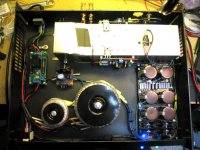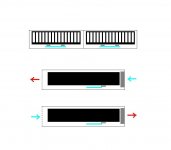sorry , way to easy to misunderstand things on the internet . personally i thing nelson's design is very newbie friendly . the costs do add up but hey . however sometimes it's not the costs but availability of something like the heat sinks in dimensions that meet the needs of the design AND our available space . like mine .
mine won't be racked , but will be on a second shelf of my setup . 10" height available . (i'm NOT removing my turntables from the top) . plenty of depth but the only other options for heatsinks are few and wayyyyy more expensive .
anyway ..........
cheers Woody
mine won't be racked , but will be on a second shelf of my setup . 10" height available . (i'm NOT removing my turntables from the top) . plenty of depth but the only other options for heatsinks are few and wayyyyy more expensive .
anyway ..........
cheers Woody
but will be on a second shelf of my setup . 10" height available .
rack sytem ?
thats not good
we are talking heavy classA...lots of heat, really
you need all the ventilation you can possibly get
on a hot summer it can turn a smaller room into a tropical adventure
well, yeah, the more heavy and expencive parts are more or less indestructable
and fits into other NelsonPass designs
worst that could happen is trouble getting well matched transistors
but still, if you want a good amp, I think it would be wise to practice a bit, soldering etc, before burning these fine top grade components
maybe we should ask Nelsonfor a low power "trainee" design
similar to F5
maybe 5watt or so
with TO-220
ordinary cheap components
cheap heatsinks
etc
but it would probably turn into a balanced monster, sooner or later
I totally understand what you're saying, and would try to find something with those sort of guidelines! but unfortunately, i already have the boards and parts being shipped to my house.
Also my thoughts on putting the Amp in a rack, would be to build a single(or double, most likely single) unit that would house fans, and a power supply to run them, and use maybe 3 low powered fans on each side, that would push air up the entire rack. so the amp would be mounted higher, and in a completely seperate case in the rack, or even if i designed it to sit directly above a few fans moving air across the heat sink. Still something to play with the thought of? but I would build the rack so that there were several inches on each side of the components to allow for airspace, and then maybe vent the top? just to get more flow then natural convection, but not so much that you start hearing significant noise. It would also be built to plug into 110, so that your not drawing off a source so close to the amplifier that you obtain electrical noise
I totally understand what you're saying, and would try to find something with those sort of guidelines! but unfortunately, i already have the boards and parts being shipped to my house.
Also my thoughts on putting the Amp in a rack, would be to build a single(or double, most likely single) unit that would house fans, and a power supply to run them, and use maybe 3 low powered fans on each side, that would push air up the entire rack. so the amp would be mounted higher, and in a completely seperate case in the rack, or even if i designed it to sit directly above a few fans moving air across the heat sink. Still something to play with the thought of? but I would build the rack so that there were several inches on each side of the components to allow for airspace, and then maybe vent the top? just to get more flow then natural convection, but not so much that you start hearing significant noise. It would also be built to plug into 110, so that your not drawing off a source so close to the amplifier that you obtain electrical noise
Yeah, generally when people talk of fan noise they mean the direct sound of the fan, not electrical noise. having them powered as you say is probably a good thing but but to test the amp you could just have a house fan blowing on the heatsinks.
There are thermostatic switched available the open mechanically at certain temperature. Might put one on each heatsink and run the AC power through them to the power supply so that if they overheated, the power would cut out. Again, I'd wait until you get it running.
Yeah, generally when people talk of fan noise they mean the direct sound of the fan, not electrical noise. having them powered as you say is probably a good thing but but to test the amp you could just have a house fan blowing on the heatsinks.... Again, I'd wait until you get it running.
right, which is part of the reason i would use low powered ones, or i could go to a computer store and order what i would believe to be quiet fans? if i recall there are some fans designed for that purpose, to be quiet. So i would only do as many as necessary to improve flow through the rack, and still have it be quiet.
Also i planned on making sure i had sufficient heat sinks! never did i intend on shorting the cooling ability, because i'm not completely set on putting in a rack, while it was my intention, its not a requirement in this build. So to test, and even until i have a permanent rack to put it in, it will sit out, where it gets plenty of ventillation. i was just talking about the fans in terms of helping the amp inside of a confined space, which setting thermally switched fans, or a thermal 'safe switch' is a good idea! but i'm afraid in a rack, that if the amp just gets too hot, that it will end up cutting the power supply constantly, and you end up having the amp shut off every few minutes, which putting the amp in a rack would have to be another spot where monitering while being played, will probably be vital until i'm sure it doesn't overheat.
Another idea was building a setup where the amp was 'encased' inside another rackmount piece, that pulled air from in front of the rack, blew it up across the heat sinks, and then back out the front on top? just more ideas. but like i said, im not set on getting it into a rack
While this has a lot about more elaborate F-5 variations, it has a lot of good info and especially some good links,
including a BOM (bill of materials)
http://www.diyaudio.com/forums/blogs/cviller/191-gb-f5-guide-pcb-version-2.html
including a BOM (bill of materials)
http://www.diyaudio.com/forums/blogs/cviller/191-gb-f5-guide-pcb-version-2.html
what is a tunnel arrangement??
What does it sound like?
For a racked amp, i would use a tunnel.
yeah, ok
if you have to use fans anyway, fan tunnels are the way to do it
but I think they are out of fashion
different types used today
or could look like this
but may be difficult to handle
it can work both ways
either by pushing/blowing cool air into the system
or by sucking out the hot air
in modern pro amps you may find both ends of the cooling system connected directly to the room, basicly free of the box
much like a tunnel through a mountain
but may be difficult to handle
it can work both ways
either by pushing/blowing cool air into the system
or by sucking out the hot air
in modern pro amps you may find both ends of the cooling system connected directly to the room, basicly free of the box
much like a tunnel through a mountain
Attachments
I went with 4 10" sections of this from Heatsink USA for my dual stereo F5s:
HeatsinkUSA
It wasn't cheap but their prices seemed to be the best for us stateside guys, shipping was prompt and they showed up well packed and look great...
For reference, they're roughly 10#s a piece.
HeatsinkUSA
It wasn't cheap but their prices seemed to be the best for us stateside guys, shipping was prompt and they showed up well packed and look great...
For reference, they're roughly 10#s a piece.
Last edited:
sorry but that was completely uncalled for in my opinion.
no i'm not an expert . i'm a beginner...
But you responded to:
Quote:
Originally Posted by crazycody1993
like i said prior, i'm brand new to the electronics world, so i'm very short on knowledge....
maybe we should ask Nelsonfor a low power "trainee" design
similar to F5...
It seemed totally obvious to me that he was not responding to you? Personally, I think your response is totally uncalled for, along with your over zellous P.I. 1911A1 monicor. I know I'm not being a good member at this moment but, maybe your the one who needs to learn his place. Maybe just lurk and learn a little more? If your a beginner, you should understand you probably need to back off and read some more? You, Tinitus, and I, are not the only members here, Knowledgable people will not respond to that seudo well spoken garbage Mr.1911. Maybe we could get away from the banter and get on with the knowledge and experience?
Parton my OT bantor for the real DIY folk.
I think I'll try to calm myself and go upstairs and look for some parts to test a Heat Sink USA H.S...

sounds like a good plan
but i do agree with your feelings. i thought maybe i was reading wrong, but i'm glad i'm not the only one! i dont feel like anything has been intended as condescending.
but! i'm looking forward to seeing your results!
- Status
- This old topic is closed. If you want to reopen this topic, contact a moderator using the "Report Post" button.
- Home
- Amplifiers
- Pass Labs
- F5 Heat sinks

